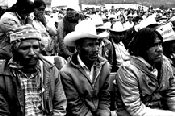INDIGENOUS IDENTITY IN THE MEXICAN CENSUS

The Mexican Republic of the Twenty-First Century, boasting more than a 100 million inhabitants, has evolved from many indigenous nations five centuries ago into a single national entity, with Spanish as its primary language. But beneath the Spanish culture and language, the indigenous identity of the Mexican people is unmistakable. It is manifested in their appearance, their culture and spirituality and, to some extent, in their language and traditions. Few of the original Indian cultures still exist in their pure and untainted forms, but most are present in some form in various traditions, customs and religious practices.
However, for the most part, the census has not been able to gauge the level of indigenous identity beyond the criteria of those who actually speak indigenous languages. In 1895, 26.09% of persons five years of age and older in the Mexican Republic spoke indigenous languages. By 1940, this figure had dropped to 14.8%. It dropped farther to 11.2% in 1950, 7.5% in 1990 and 7.1% in 2000. The linguistic status, however, does not necessarily explain if a Mexican citizen feels that he or she is an Indian by blood, by culture, or tradition. However, the 1921 and 2000 Mexican Federal Censuses stand out as exceptions. In these two censuses, performed 79 years apart, we get a unique view into the ethnic identity of the Mexican people.
In the 1921 census, Mexican natives were asked if they fell into one of the following categories:
- “Indígena pura” (of pure indigenous heritage).
- “Indígena mezclada con blanca” (of mixed indigenous and white background)
- “Blanca” (of White or Spanish heritage).
- “Extranjeros sin distinción de
razas” (Foreigners without racial distinction).
The five states with the largest populations of “indígena
pura” were:
- Oaxaca – 675,119 persons
- Puebla – 560,971 persons
- Veracruz – 406,648 persons
- México – 372,703 persons
- Guerrero – 248,526 persons
- Oaxaca – 69.17%
- Puebla – 54.73%
- Tlaxcala – 54.70%
- Chiapas – 47.64%
- Yucatán – 43.31%
In the 1921 census, the status “Indígena Mezclada con Blanca” implied that a person was of mestizo origin. Persons classified by this identity usually did not speak Indian languages, but still felt an attachment to their indigenous roots. The five Mexican states with the largest populations of “Indígena Mezclada con Blanca” were:
- Jalisco – 903,830
- Guanajuato – 828,724
- Michoacán – 663,391
- Veracruz – 556,472
- Distrito Federal – 496,359
The states with the largest percentages of “Indígena
Mezclada con Blanca” were:
- Sinaloa – 98.30%
- Guanajuato – 96.32%
- Durango – 89.10%
- Zacatecas – 86.10%
- Querétaro – 80.15%
- Distrito Federal – 206,514
- Chihuahua – 145,926
- Sonora – 115,151
- Veracruz – 114,150
- México – 88,660
In percentage terms, the “blanca” classification was most
prominent in these states:
- Sonora – 41.85%
- Chihuahua – 36.33%
- Baja California Sur – 33.40%
- Tabasco – 27.56%
- District Federal – 22.79%
Seventy-nine years later, the 2000 census attempted to
determine the number of Mexican people who considered
themselves to being indigenous, without reference to
language. In
order to calculate the indigenous people, the census used
three criteria:
- Persons who speak indigenous languages (aged 5 and over)
- Persons aged 0 through 4 who live in indigenous households
- Persons who consider themselves Indian but do not speak an indigenous language.
The five states with the largest numbers of persons classified as “Indígena” in the 2000 census were:
- Oaxaca – 1,648,426 persons
- Chiapas – 1,117,597
- Veracruz – 1,057,806
- Yucatán – 981,064
- Puebla – 957,650
The five states with the largest percentages of Indigenous people were:
- Yucatán – 59.2%
- Oaxaca – 47.9%
- Quintana Roo – 39.3%
- Chiapas – 28.5%
- Campeche – 26.9%
In contrast, the five states with the largest numbers of persons who spoke indigenous languages and were five years of age or more were:
- Oaxaca – 1,120,312 speakers of indigenous languages
- Chiapas – 809,592
- Veracruz – 633,372
- Puebla – 565,509
- Yucatán – 549,532
Of great interest to some people would be the states with the least populations of indigenous persons in the 2000 census:
- Aguascalientes – 3,472 persons
- Zacatecas – 4,039 persons
- Colima – 6,472 persons
- Coahuila – 7,454 persons
- Baja California Sur – 11,481 persons
In terms of percentages, the five states with the smallest percentages of indigenous persons were:
- Zacatecas – 0.3%
- Coahuila – 0.3%
- Aguascalientes – 0.4%
- Guanajuato – 0.6%
- Nuevo León – 0.8%
While many of the inhabitants of Aguascalientes, Zacatecas, and Guanajuato do have indigenous roots, the level of assimilation and mestizaje that took place in these areas over the last four centuries has diminished the original Indian identity.
The indigenous identity of the Mexican people is hard to quantify and classify from one state to another, from one linguistic group to another, so census statistics cannot be considered entirely reliable. However, the 1921 and 2000 censuses do give us the best view of indigenous identity, when compared to other census years.
© 2004, John P. Schmal. All rights reserved.
CONAPO, Cuadro 1. Poblacion Total, Poblacion Indigena, y Sus Caracteristicas.”
Schmal, John P.
Indigenous Mexico: A State-by-State Analysis (manuscript in progress, 2004).
Copyright © 1996-125
This page last updated 05/23/2019 14:55:41
This site has been accessed 10,000,000 times since February 8, 1996.